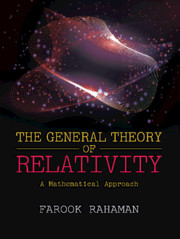Book contents
- Frontmatter
- Dedication
- Contents
- List of Figures
- List of Tables
- Preface
- Acknowledgments
- Chapter 1 Tensor Calculus — A Brief Overview
- Chapter 2 Geodesic
- Chapter 3 Einstein Field Equations
- Chapter 4 Linearized Gravity
- Chapter 5 Lie Derivatives and Killing’s Equation
- Chapter 6 Spacetimes of Spherically Symmetric Distribution of Matter and Black Holes
- Chapter 7 Particle and Photon Orbits in the Schwarzschild Spacetime
- Chapter 8 Causal Structure of Spacetime
- Chapter 9 Exact Solutions of Einstein Equations and Their Causal Structures
- Chapter 10 Rotating Black Holes
- Chapter 11 Elementary Cosmology
- Chapter 12 Elementary Astrophysics
- Appendix A Extrinsic Curvature or Second Fundamental Form
- Appendix B Lagrangian Formulation of General Relativity
- Appendix C 3+1 Decomposition
- Bibliography
- Index
Chapter 1 - Tensor Calculus — A Brief Overview
Published online by Cambridge University Press: 24 March 2021
- Frontmatter
- Dedication
- Contents
- List of Figures
- List of Tables
- Preface
- Acknowledgments
- Chapter 1 Tensor Calculus — A Brief Overview
- Chapter 2 Geodesic
- Chapter 3 Einstein Field Equations
- Chapter 4 Linearized Gravity
- Chapter 5 Lie Derivatives and Killing’s Equation
- Chapter 6 Spacetimes of Spherically Symmetric Distribution of Matter and Black Holes
- Chapter 7 Particle and Photon Orbits in the Schwarzschild Spacetime
- Chapter 8 Causal Structure of Spacetime
- Chapter 9 Exact Solutions of Einstein Equations and Their Causal Structures
- Chapter 10 Rotating Black Holes
- Chapter 11 Elementary Cosmology
- Chapter 12 Elementary Astrophysics
- Appendix A Extrinsic Curvature or Second Fundamental Form
- Appendix B Lagrangian Formulation of General Relativity
- Appendix C 3+1 Decomposition
- Bibliography
- Index
Summary
Introduction
The principal target of tensor calculus is to investigate the relations that remain the same when we change from one coordinate system to any other. The laws of physics are independent of the frame of references in which physicists describe physical phenomena by means of laws. Therefore, it is useful to exploit tensor calculus as the mathematical tool in which such laws can be formulated.
Transformation of Coordinates
Let there be two reference systems, S with coordinates (x1, x2,…xn) and with coordinates. (Fig. 1). The new system S depends on the old system S as
Here ϕi are single-valued continuous differentiable functions of (x1, x2,…xn) and further the Jacobian
Differentiation of Eq. (1.1) yields
Now and onward, we use the Einstein summation convention, i.e., omit the summation symbol Σ and write the above equations as
The repeated index r or m is known as dummy index. The index i is not dummy and is known as free index.
The transformation matrices are inverse to each other
The symbol is Kronecker delta, is defined as
Obviously vectors in system are linked with (S) system
Covariant and Contravariant Vector and Tensor
Usually one can describe the tensors by means of their properties of transformation under coordinate transformation. There are two possible ways of transformations from one coordinate system .xi) to the other coordinate system .
Let us consider a set of n functions Ai of the coordinates xi. The functions Ai are said to be the components of covariant vector if these components transform according to the following rule
Also, one can find by multiplying and using and
Gradient of a scalar is a covariant vector.
Here, Ai is known as the covariant tensor of first order or of the type (0, 1).
The functions Ai are said to be the components of the contravariant vector if these components transform according to the following rule
Also, one can find by multiplying both sides with and using
Here, Ai is known as the contravariant tensor of first order or of the type (1, 0).
- Type
- Chapter
- Information
- The General Theory of RelativityA Mathematical Approach, pp. 1 - 44Publisher: Cambridge University PressPrint publication year: 2021



